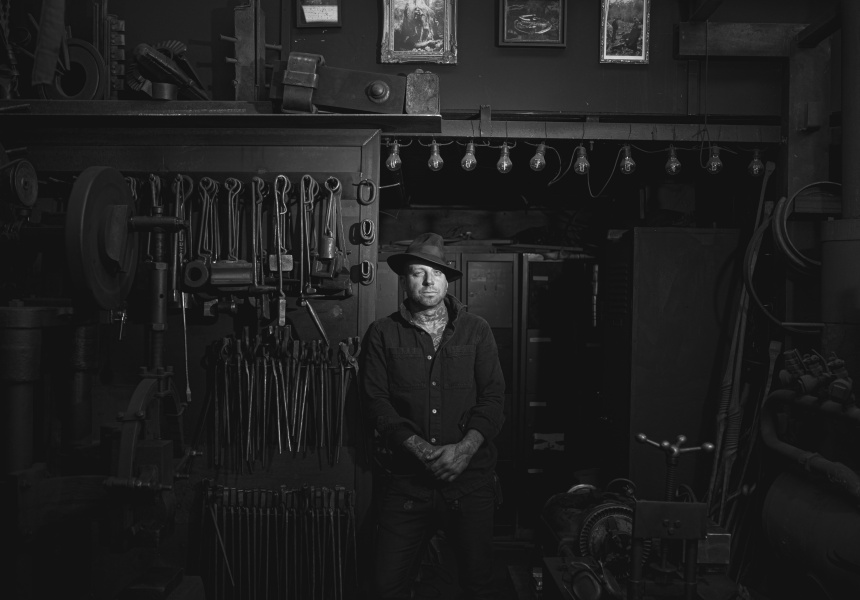Pete Mattila had no idea blacksmithing would take him down the path of creating fire-breathing sculptures and outdoor cooking rigs, or drawing on old-growth forests and river sludge to create beautiful pieces. Born in Michigan, he trained as an industrial blacksmith and completed a visual arts degree, splitting his time between Australia and the US. One day he woke in Nevada with the sounds of Tasmanian birds in his head. “They were haunting my dreams,” he says – and he realised he was in love with Tasmania. Drawn to the bush, the landscape and the isolation, Mattila realised it was the place to put down roots and open a workshop.
Mattila has built himself such a reputation that clients are often happy to let him do his thing. They’ll come to him with a request – anything from gates to a table or a sculpture. Mattila will visit the space or site where the piece will reside, and then will have carte blanche on the project.
Some of Mattila’s larger works include a five-and-a-half-tonne fire-breathing sculpture powered by natural gas, a sculptural working fireplace suspended from the ceiling as a hero piece in a tiny home build that appeared on Grand Designs, and an outdoor cooking rig for Matthew Evans and Sadie Chrestman’s Fat Pig Farm.
In his studio, large machinery including a power hammer, a mechanical hammer, and hydraulic presses dominate the space, along with furnaces that “get to an easy 1200 degrees Celsius”.
Recently, he has been creating material from the forest in the Weld Valley. After the area was logged, then burnt, Mattila collected charcoal and decided to use it in a smelting process by adding local iron ore (magnetite), in order to make a bloom (the traditional way to make steel). The process resulted in a lump of metal that was rough on the outside, perfectly smooth on the cutting edge, and mighty heavy. Mattila reflects, “In a metaphysical way we have fused this Tasmanian forest with local ore to create steel. “Blacksmithing is about transformation – that’s what underpins a lot of the creative process. It’s ancient yet very much contemporary.”
Mattila has also created material from the Queen River in the state’s west, which has been labelled polluted from years of mining. In partnership with chemist Brenda Mooney and experienced bloom maker James Rhys Harvey, Mattila took the “dead sludge” and dehydrated it down to get a fine powder, deep ochre in colour, like the river. Reducing it further, it becomes iron and red like the outback. Finally, it’s worked over in a long, slow furnace, and all the “gross dead river sulphites” are burned away and it starts to become magnetic. It’s a labour of love, experimentation, and dedication, and ultimately produced a workable material Mattila has fashioned into objects. “It’s about going into a damaged site, acknowledging there’s a problem, and finding a way to transform it into something amazing.”
After 17 years of working in metal, Mattila retains the same passion that fuelled him in the beginning. “I’m very obsessed with my work. I get the critique that I’m a workaholic, but are you a workaholic if you love what you do?” There’s also a responsibility Mattila feels as a blacksmith. Historically, “blacksmiths keep the community going”, and indeed, people drop by his place with tools and trailers that need fixing.
During the Off Season, he holds workshops, imparting his knowledge to small groups. The fires warm the studio, and students walk away with new old skills, and steel knives they forged themselves. “It’s an absolute joy to be out in the fresh winter air in Tassie,” Mattila says. “I started doing cold dips last winter,” he adds, indicating where he jumps in the River Derwent, metres from his workshop. “When I do that first thing in the morning, I think, ‘Whatever happens today will be easy in comparison.’ It reminded me that all the medicine I need is right out the front door.”
This article is produced by Broadsheet in partnership with Tourism Tasmania. Explore more wild, weird and wonderful experiences during Tasmania’s Off Season.

